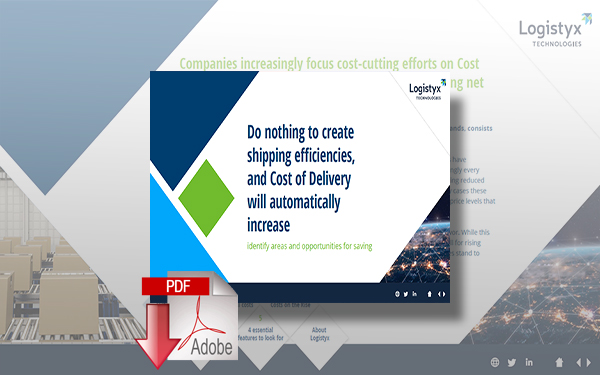Implementing a TMS for Parcel Shipping Can Save Even More than You Think

Recurring savings is the grand prize for shippers...finding those savings, however, can feel downright impossible.
TMS Parcel Shipping
Customers want the world and then some, including fast, free, intelligent shipping, and this often comes at a significant cost.
Fortunately, shippers can better understand their savings roadblocks by applying the sophisticated Business Intelligence available in a TMS for parcel shipping. Of course, other benefits also come with implementing a TMS for parcel shipping, including automated carrier selection, parcel consolidation, enhanced visibility, and more.
Where Do “Cost Parasites” Exist in the Modern Supply Chain?
High transportation costs have become routine in the modern supply chain. As customers increasingly demand free and same-day/next-day shipping, supply chains must respond with faster, more dependable services.
These services come at a cost, which eats away at profitability. Before making any changes, however, supply chain leaders need to understand where – and why – they’re sustaining financial hits and how these hits drag an organization down.
1. Poor Visibility into Carrier Performance
Shippers without the ability to track carriers’ on-time-delivery rates risk increasing their transportation spend. They lack the necessary data to truly evaluate carrier performance, and therefore carrier selection is uninformed and they’re at a disadvantage when it comes to carrier negotiations.
Poor visibility also means the shipper has no way of communicating transportation updates to the customer – including delays – and uninformed customers are often unhappy customers, demanding a full refund for shipping costs or even a full refund for the purchase price.
Perhaps even worse: according to a study from OSM Worldwide, two-thirds of online shoppers will express frustration to friends and family when a package doesn’t arrive as expected.
Finally, according to a report from project44, 85% of marketers claimed delivery is moderately to very important to their customer experience and brand.
This means for retail shippers, working on the customer experience post-checkout is essential for repeat purchases. An unfortunate byproduct of the poor customer communication described above: when a customer is disappointed, his or her loyalty to the shipper will also decline — leading them to consider competitors’ products.
Finally, according to a report from project44, 85% of marketers claimed delivery is moderately to very important to their customer experience and brand. This means for retail shippers, working on the customer experience post-checkout is essential for repeat purchases. An unfortunate byproduct of the poor customer communication described above: when a customer is disappointed, his or her loyalty to the shipper will also decline — leading them to consider competitors’ products.
2. Inability to Leverage Shipping Data
Shippers without the ability to analyze real time shipping data in a Business Intelligence platform fail to understand how factors such as distance, speed to delivery, package size, and density affect spend within their transportation carrier landscape.
They can’t visualize how and where changes are planning to (or should) occur, and this means they’re on their back foot when it comes to carrier negotiations.
For instance, if a shipper is implementing changes in fulfillment to increase ship-from-store or locate a new DC, understanding how these changes impact zone and carrier service-level downgrade options are critical.
In addition, shippers without real-time data and the Business Intelligence to put this data to work can’t answer questions, such as:
- What is the impact of a proposed carrier rate change on spend?
- What are the available transportation savings with newly proposed carrier options?
- How will ship-from-store or new DC placement affect spend?
By harnessing this data and using proper Business Intelligence tools, shippers can extrapolate transportation spend impacts across significant data sets and visualize the effects across variables such as weight breaks, zones, regions, service levels, etc.
This visualization will allow shippers to easily identify areas ripe for further negotiation and empower them to make cost-savvy supply chain decisions that align with business strategy.
Finally, leveraging data to perform predictive analytics in logistics can help shippers reduce costs by making real-time procurement a real-life possibility. Identifying the ideal combination of carriers requires simulation analysis. If all carriers delivered to all regions with all services 100% on time, this would be a simpler exercise.
But carriers don’t always perform at 100%, and by understanding where carriers perform well (and not) and leveraging this information within procurement simulations, shippers can rapidly evaluate predicted delivery performance and cost impacts, identifying the optimal carrier service combination based on factors such as service, price, capacity, and quality.
3. Failure to Take Advantage of Parcel Consolidation
Parcel consolidation is critical to keeping parcel shipping spend in check, especially in lieu of recent rate hikes by UPS, FedEx, and DHL. If a shipper is shipping large amounts of orders to the same corner of the world, there’s no need to pay the highest price for every parcel.
Shippers can save on shipping costs by consolidating parcel shipments and finding the best rate across carriers for any destination. For example, paying for several parcel shipments for multiple orders may be more costly than combining those orders into one larger shipment and sending it via LTL.
Another benefit of lower shipment volume can be a decrease in the amount of time spent processing orders in the warehouse and managing back-end finance and administrative operations, which ultimately helps to lower costs as well.
Using a TMS for Parcel Shipping Unlocks Parcel Shipping Savings
Today’s high transportation costs are the result of putting new processes in place to give customers what they want— fast and free shipping. In the age of Amazon and Alibaba, this is non-negotiable, and shippers are left holding the proverbial bag.
At the same time, rate hikes occur. Shipping volumes increase. Cross-border challenges arise. There’s massive uncertainty. Fortunately, using a Transportation Management System (TMS) for parcel shipping can unlock significant savings, provided shippers understand how to maximize its value.
How to Maximize ROI and Savings with a TMS for Parcel Shipping
Maximizing the value of a TMS for parcel shipping may sound simple, but as we know all too well, to squeeze the most profit out of every shipment, shippers have to go beyond just printing the right label – integrating the TMS for parcel shipping technology with business-critical systems to leverage business intelligence cross-functionally, measure performance, and react quickly. And this is more challenging.
With that said, there are three ingredients — integrations and Professional Services, technology, and Business Intelligence — that are foundational to any successful TMS for parcel shipping solution implementation. Here’s what goes into this winning trifecta:
1. Integrations and Professional Services
Despite the impressive functionality in most parcel shipping technology solutions, critical to a shipper’s success will be how well the technology integrates with both the carriers’ systems as well as the ERP, WMS, OMS and/or e-commerce systems.
Shippers need a solution provider with significant integration experience across a broad network of global carriers and world-leading enterprise, e-commerce, and supply chain software providers – in either a blackbox or attended environment.
Shippers also need a Professional Services team capable of evolving the TMS for parcel shipping technology instance as their shipping strategy becomes more complex, willing to coach and train their people.
Shippers require folks who have their back and on whom they can rely to spearhead the conversation that moves their shipping strategy forward.
They need people that know how to leverage and inform the implementation and integration processes and technologies that streamline shipping workflows and make distributing and managing shipping data easier. The list goes on and on, but you get the gist — Professional Services are key.
2. Technology
As an organization matures, distribution scenarios will likely become more complex. This means there will be more shipments, more carrier services, more warehouses, and more data to manage.
Technology can help streamline every stage from carrier services procurement to carrier invoice reconciliation and reporting. For example, the right TMS for parcel shipping technology:
- Gives Customer Service teams 24/7, on-demand access to critical delivery event details, and dashboards display KPIs such as Total Shipments, Exceptions, Packages In-Transit, Delivered, Late, and Lost so these teams can proactively communicate with customers and protect the customer relationship.
- Automates carrier selection, produces all necessary labels and documentation, and helps organizations scale and improve their shipping efforts – even across borders.
- Performs mode shopping within the contracted carrier network to determine whether packages – both domestic and international – should go LTL vs. parcel and compares carriers and services to find the best rate. It helps optimize volume discounts and zone skipping and avoid accessorial charges – cutting costs and increasing resource efficiency almost immediately.
- Automatically compares carrier invoices against expected transportation costs and automates claims filing and payment and reports on spend according to geography, business unit, accruals, and GL Coding, to name a few.
3. Business Intelligence
A huge part of achieving cost-effective parcel shipping has to do with the creation, distribution, and management of data. While it’s a somewhat vague term, “data” includes everything from delivery event alerts and carrier service scorecards to rate simulations, cost accounting, and more.
Without accurate data and the proper management of it, shippers will have a harder time securing favorable contracts with carriers.
TMS for parcel shipping technology with a Business Intelligence platform will understand how factors such as distance, speed to delivery, density, and package size affect spend within the transportation carrier landscape, and analyze shipping data in real-time to visualize how and where changes should occur for the shipper to yield greater returns.
Recapture Costs through Better Logistics Management and a Robust TMS for Parcel Shipping Now
A robust TMS for parcel shipping will empower shippers to recapture expenses and keep parcel shipping spend under control. While literally thousands of modern systems exist, it is equally important to look for a system and vendor with a well-established reputation and deployment model. Logistyx has this reputation and model and can help your company achieve strong ROI and significant savings.
Related: How a Transportation Management System (TMS) for Parcel Shipping Empowers Shippers 
Related White Paper
Ignoring Shipping Efficiencies Will Result in Increased Cost of Delivery
Companies increasingly focus cost-cutting efforts on Cost of Distribution, and it’s paying off by quickly reducing net landed cost of goods and improving profitability. Download Now!
Article Topics
Logistyx Technologies News & Resources
Prologis and Home Depot leadership address the capabilities of AI for logistics Maersk addresses flexibility and variability with innovation Embracing the Cross-Border E-Commerce Opportunity Optimize Your Parcel Shipping Strategy Why Peak Season Planning Needs to be a Year-Round Endeavor 7 Logistics Trends that will Radically Change the Shipping Landscape in 2022 E2open makes second acquisition in less than a year, bringing Logistyx Technologies into the fold More Logistyx TechnologiesLatest in Transportation
Trucking Industry Pushes Back on Government’s Electric Mandates Maersk Sees Silver Lining in Red Sea Shipping Challenges Baltimore Opens 45-Foot Deep Channel Following Bridge Collapse El Paso Border Delays Cost Juarez $32 Million Per Day in Economic Losses Ranking the World’s 10 Biggest Supply Chains The Top 10 Risks Facing Supply Chain Professionals Walmart’s Latest Service: Ultra Late-Night Delivery More Transportation














